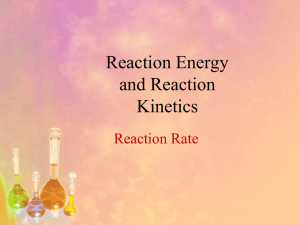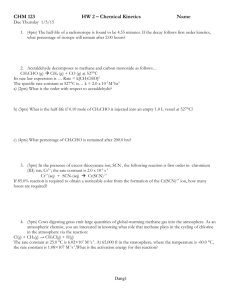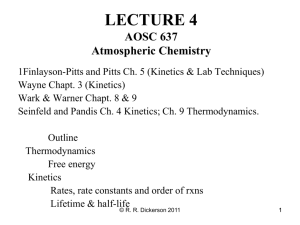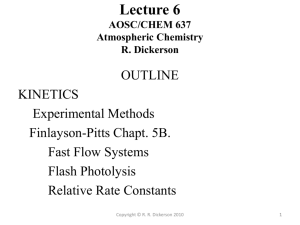LECTURE 7
advertisement
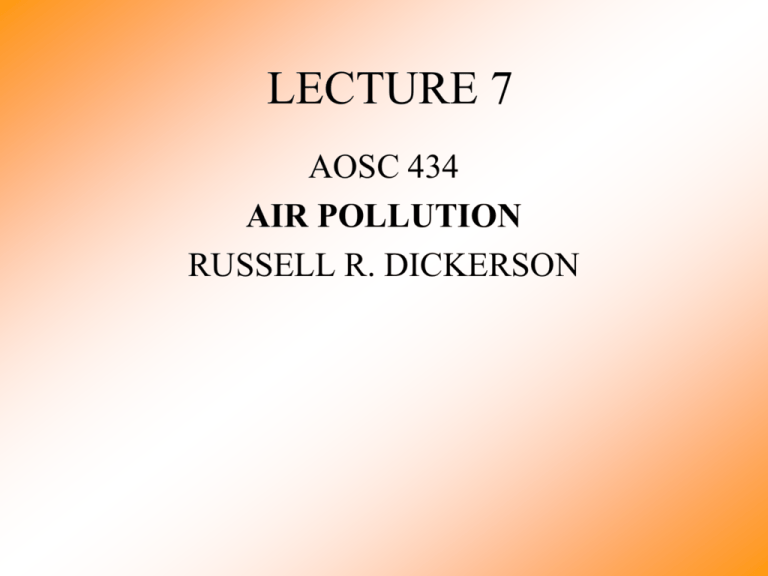
LECTURE 7 AOSC 434 AIR POLLUTION RUSSELL R. DICKERSON RECAP. THERMODYNAMICS G H TS G RT ln( K eq ) K eq G e RT H 0 G 0 GT H T 298 0 III. KINETICS a) Rates, Order, Lifetime Thermodynamics tells what is forbidden and provides equilibrium concentrations, but tells us nothing about what can happen, how fast it happens, or even if it happens in a finite amount of time. Kinetics provides the information needed to find out how fast reactions occur. Much of air pollution is the result of slow kinetics causing reactions to fail to go to completion. If thermodynamics alone ruled the universe, we would all be little more than puddles of warm Perrier. Consider the indoor air pollutant radon 222 (²²²Rn). The EPA has accused this noble gas of causing a great deal of lung cancer through its radioactive decay. The red line describes first order loss with a rate constant of 1 min-1 The blue line describes the rate of formation of the product. minutes © R. R. Dickerson 2011 4 222 Rn 218Po An inert gas cannot stick in your lungs, but particles can. Not only is radon itself radioactive, but its daughters, starting with Polonium 218, are also alpha emitters. These daughters have a very low vapor pressure, and stick readily to aerosol particles. The particles then can stick to your lungs, as we shall see in a later lecture. If an unvented room contained a known amount of radon 222, how long would it take for the radon to decay? The concentration changes as shown in the following image. It looks as if the decay of Rn is exponential, and we can test for this by plotting the logarithm of the concentration as a function of time We see that the following relationship holds. ln([ Rn ]t ) k t ln([ Rn ]0 ) Where k is the slope and ln([Rn]₀) is the Y-intercept. The rate of decay of radon seems to depend only on the concentration of radon. What is the origin of this relationship? d[Rn]/dt = -k [Rn] We can solve for the concentration of radon as a function of time by first separating the variables: 1 d [ Rn ] k dt [ Rn ] Integrating both sides from time zero to t yields: t t 1 0 [ Rn ] d [ Rn ] 0 k dt ln[ Rn ]t ln[ Rn ]0 kt [ Rn ]t kt ln [ Rn ]0 The most useful form of this expression is: [ Rn ]t e ( kt ) [ Rn ]0 This is reaction is said to be first order because its rate depends on only one reactant, in this case radon. The order of a reaction is the number of reactants actually involved in the chemistry. In general a first order reaction takes the form: A → products The slope mentioned earlier, k, is the rate constant for the reaction. The units of any reaction are concentration per unit time, thus the units of the rate constant for a first order reaction must be time⁻¹. For example, the rate of loss of a species could be expressed in: M/s, ppm/min, (μg m⁻³)/hr, or (molecules/cm ³)/s. The most common units for gas-phase kinetics are molecular number density or molecules per cubic cm. Remember that air has 2.7x1019 cm⁻³, at STP and 2.5x1019 cm⁻³ at RTP. The half-life of a species is the time it takes for the original concentration to be reduced to one-half. Thus after n half lives: [ Rn ]t 1 n [ Rn ]0 2 For Rn the half-life is 3.8 days, but for first order reactions, a more natural expression of the lifetime is the time equivalent to the inverse of the first order rate constant. If t = 1/k, then: [ Rn ] e ( tk ) e 1 0.37 [ Rn ]0 The lifetime (1/k) is given the symbol τ. Tau is sometimes referred to as the “e-folding” lifetime. The half-life and lifetime are related by a constant. [ A]t 1 / 2 e ( k t1 / 2 ) [ A]0 ln( 1 / 2) k t1/ 2 t1/ 2 ln( 2) ln( 2) k The lifetime of radon is five and a half days; Rn 5.5 d Nitric acid anhydride, N₂O₅, decomposition at sea-level pressure provides another example of a process with first order kinetics. N 2O5 NO2 NO3 d [ N 2O5 ] / dt d [ NO2 ] / dt [ NO3 ] / dt k [ N 2O5 ] [ N 2O5 ]t e( k t ) [ N 2O5 ]0 A general expression for the product is: [ NO 2 ]t 2 e ( k t ) [ NO2 ]t1 Many reactions leading to or removing air pollution from the atmosphere require more than one chemical. Those with two reactants are second order. In general A + B → Products The rate equation is d[A]/dt = d[B]/dt = – k[A][B] If A and B are the same, we can integrate the rate equation to find the concentration of the reactant as a function of time. A A prod . d [ A] / dt 2k [ A]2 t t 1 0 [ A]2 d [ A] 0 2kdt 1 1 2kt [ A]0 [ A]t This can be rewritten with the initial concentration as a constant. 1 /[ A]t 2kt 1 /[ A]0 A few reactions of combustion or atmospheric interest follow such kinetics, for example at constant pressure: O + O → O₂ N + N → N₂ Two different reactants are more common, in fact the majority of reaction in air pollution have the kinetic form of the following examples. NO + O₃ → NO₂ + O₂ CO + OH → CO₂ + H H₂S + OH → H₂O + HS The units of the rate of a reaction are still concentration per unit time, thus second order rate constants must have units of (conc⁻¹ time⁻¹ ), such as (M ⁻¹ s ⁻¹ ), or (ppm⁻¹ min⁻¹), or ( (molecules/cm³) ⁻¹ s⁻¹ ). These last units are the most common in gas-phase kinetics, but they are usually written with the “molecules” understood, i.e. cm³ s⁻¹ . Notice that the rate for all irreversible reactions is independent of the concentration of the products. Because the rate of a second order reaction depends on two concentration, we cannot define a lifetime in the same sense as a first order lifetime. If, however, one of the reactants is in great excess over the other, we can define a pseudo first order rate constant. If [B] is approximately constant, then k ' k [B ] 1 1 A k [B ] k ' If A is constant or in great excess over B then we can calculate the lifetime of B the same way. Some reactions proceed only when three species come into contact simultaneously. These reactions are third order. A + B + C → Products The rate equation is: d[A]/dt = d[B]/dt = d[C]/dt = – k[A][B][C] Prominent examples of atmospherically significant third order reactions are: 2 NO O 2 NO 2 2 O O2 M O3 M d [O ] / dt d [O2 ] / dt d [O3 ] / dt k [O ][O2 ][ M ] The “M” in the formation of ozone appears on both sides of the equation, so in not necessary for the stoichiometry of the reaction, but it plays a critical role in the kinetics of the reaction. The formation of ozone proceeds with the release of considerable energy, thus third body is required to remove the excess energy; otherwise the reaction will not proceed. Most addition reactions require a third body. Sulfur dioxide from coal burning can start down the road to sulfuric acid with the following reaction. SO₂ + OH + M → HOSO₂ + M The units of the rate of the reaction are still concentration per unit time, but the units of a third order rate constant must be conc⁻² time ⁻¹. The most common units are cm⁶ s ⁻¹. As a general rule, for a reaction of order n, the units of k are: conc ( n 1)time1. Again “lifetime” has no meaning for a third order reaction, but if two of the three reactants are constant, we can define a pseudo first order rate constant k’. Let A and B be in great excess over C, then k ' k [ A ][ B ] This situation is not as unlikely as it might seem. For example pseudo first order conditions nearly always hold true for O atoms in air wherever the density and mixing ratio of oxygen are constant. 1 1 (k [O2 ] [ M ]) k ' Problem left for students: Where [M] is the sum of [N₂] and [O₂]. How does the lifetime of O atoms vary with pressure? A + B + C PRODUCTS d[A]/dt = -k[A][B][C] Examples 2NO + O2 = 2NO2 O + O2 + M = O3 + M† M is any third body (usually N2) needed to dissipate excess energy. From the ideal gas law and Avogo's number: P T0 P T0 M M0x 2.69 x1019 x P0 T P0 T Where Mo is the molecular number density at STP in molecules cm-3. Third order rate constants have units of conc-2 time-1. These are usually (cm-3)-2 s-1. kNO-O2 = 2.0 x 10-38 cm6 s-1 kO-O2 = 4.8 x 10-33 cm6 s-1 © R. R. Dickerson 2014 17 Useful idea: For the following reversible reaction: A+B↔C+D d[C]/dt = kf [A][B] - kr [C][D] At steady state d[C]/dt = 0, by definition. Thus: [C ] [ D] K EQ kr [ A] [ B] kf © R. R. Dickerson 2011 18 For second and third order reactions we can sometime approximate first order conditions – or use pseudo first order kinetics. A + B → Prod. If [B] >> [A] Then k[B] is approximately constant. We call this pseudo first order rate constant k’. k' k[B] [A] t e -k[B]t [A ]0 1 A k[B] © R. R. Dickerson 2011 19 For second and third order reactions we can sometime approximate first order conditions – or use pseudo first order kinetics. For example: NO + O3 NO2 + O2 k = 1.9 x 10-14 cm3 s-1 Assume: [O3] >> [NO] and d[O3]/dt ~ 0.0 Let: mean [O3] = 50 ppb (a reasonable value for air near the surface). NO 1 1 42s 14 9 19 k[O3 ] 1.9 x10 50 x10 2.5x10 CONCLUSION: any NO injected into such an atmosphere (by a car for example) will quickly turn into NO2 , if there are no other reactions that play a role. We will call k[O3] the pseudo first order rate constant. © R. R. Dickerson 2011 20 For third order reactions we must assume that two components are constant. k[ A][ B] 1 For example: O + O2 + M O 3 + M k = 4.8x10-33 cm6 s-1 ASSUME: d[O2]/dt = d[M]/dt = 0.0 We know that [O2] = 0.21 and that [M] ~ [O2] + [N2] ~ 1.00. At RTP P02 = 0.21 atm and PM ~ 1.0 atm. Therefore the lifetime of O atoms is 1/k[O2][M]M02 where M0 is the conversion to molecules per cm3. O 4.8 x10 33 19 2 1 x0.21x1.0 x(2.5 x10 ) = 1.6x10-6 s, short indeed! © R. R. Dickerson 2011 21 Example Same reaction at stratospheric temperature and pressure. P30km ~ P0 exp(-30/7) = 0.014 atm O 4.8 x10 33 19 2 1 x0.21x1.0 x(0.014 x 2.5 x10 ) = 2.1x10-3 s This is still short, but it is a thousand times longer than in the troposphere! The pressure dependence has a major impact on the formation and destruction of tropospheric and stratospheric ozone. Problem for the student: Compare the rate of loss of O atoms to reaction with O 2 vs. NO2 in the troposphere where [NO2] ~ 10-8 and in the stratosphere where [NO2] ~ 10-6 . © R. R. Dickerson 2014 22 If two of the reactants in a third order reaction are the same, we can derive a useful expression for the rate of loss of the reactant. A + A + B PROD For a great excess of B: d[A]/dt = -(2k[B])[A]2 [A]-2 d[A] = -(2k[B])dt t t 0 0 -2 A dA - (2kB)dt -[A]t-1 + [A]0-1 = -(2k[B])t [A]t-1 = 2k[B]t + [A]0-1 Now we can calculate the concentration at any time t in terms of the initial concentration and the rate constant k. © R. R. Dickerson 2011 23 The method works for the self reaction of nitric oxide: NO + NO + O2 → 2NO2 and shows that this reaction can ruin NO in N2 calibration standards if any air gets into the cylinder. d[O2]/dt = -k[NO]2[O2] d[NO]/dt = -2k[NO]2[O2] = 2d[NO2]/dt k = 3.3x10-39 exp (530/T) cm6 molecules-2 s-1 In the atmosphere it is only important for highly concentrated exhaust gases. © R. R. Dickerson 2011 24 Lecture Summary • Changes in enthalpy and entropy, H and S, are nearly independent of temperature. • Gibbs free energy provides the criterion of feasibility. • The residence time (lifetime), t, is the inverse of the first order rate constant, k. • If second or third order reactions can be approximated as first order then lifetimes can be estimated. • For reversible reactions, kf/kr = Keq © R. R. Dickerson 2011 25
